1 This section right here contains the text that goes inside of the tooltip.
2 This section right here contains the text that goes inside of the tooltip.
3 This section right here contains the text that goes inside of the tooltip.
What is it?
Skim through Jaguar’s expansive press kit and the three traits that standout about the new XF are that it's lighter, larger (on the inside), and more luxurious than the car it replaces. There’s a greater use of aluminium, so weight is down by up to 190kg for certain versions. The near 5-metre length and longer wheelbase equal more space in the cabin, and there’s seemingly more emphasis on comfort than the first XF. The promise is of a more rounded package and one that could win the new XF wider acceptance in India.
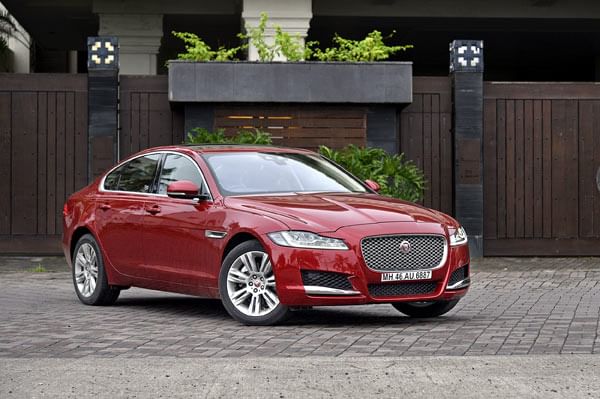
At first sight, the XF doesn’t stand out as a brand new car. Jaguar design boss Ian Callum and his team have gone for evolutionary styling and a family look, so it’s possible to pass by the new XF mistaking it for an existing Jag. However, see the car in its entirety and it’s the size, more than anything else that establishes this as the new XF. It’s a long car, but the proportions are good and the low bonnet, high boot silhouette looks swell. On offer are three trim levels (see table), with this top-spec Portfolio version’s LED headlights and 18-inch wheels doing their bit for the look. The headlights also get Jaguar’s distinctive J-blade daytime running LEDs, while the twin exhaust pipes and very F-type-like LED detailing on the tail lights add that bit of sportiness to the look too. Still, some of us feel Jaguar could have been a bit more adventurous with the design.
What is it like on the inside?
As the point of first contact, the XF’s front seats work brilliantly. The perforated leather seats look sumptuous, are supremely comfortable, and the top-spec Portfolio trim gets 14-way electric adjust, including controls for thigh support and side bolstering. However, once buckled up, there is some disappointment. Jaguar cabins, while luxurious in their own right, have never quite matched the Germans for quality and, unfortunately, that’s something you’ll see here too. There are a few hard plastics in the cabin and even bits like the buttons for the windows lack the richness we’ve seen in the newer lot of Mercs and Audis. It’s not sub-par by any standard, but Jag’s rivals have taken the game forward in this respect. The XF’s layered dashboard, though smart, also doesn’t break new ground in design. Sadly, the cowl for the new heads-up display (only on the top-spec cars) also breaks the flow of Jaguar’s trademark ‘Riva loop’ that encircles the dash.
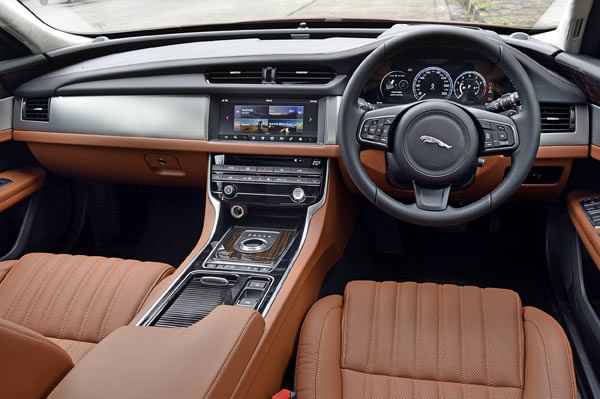
Over to the good stuff. Leading the list has to be the top Portfolio trim’s excellent 825W Meridian sound system and InControl Touch Pro infotainment system. The unit is operated via a sizeable 10.2-inch touchscreen (lower versions get an 8-inch unit) and scores really well for usability. The screen displays everything in good clarity, is very responsive to inputs and shuffles through the menus fluidly. The screen relays images from the multiple cameras around the car (ala, Land Rovers) and is where you’d end up looking when parking the big Jag yourself. The Portfolio trim cars get park assist which automatically (and deftly) steers the car into and out of a detected parking spot; all the driver needs to do is modulate the brake. Also nice is the Portfolio’s 12.3-inch fully digital instrument cluster. It’s not as sophisticated as Audi’s Virtual Cockpit system, but we like how the layout changes between driving modes. Well-executed ambient lighting (configurable on the Portfolio models) further adds that little extra sense of occasion to the cabin in the dark. And, yes, you still get the Jaguar handshake that has the side air-con vents and rotary gear lever rise on ignition.

Given how much kit Jaguar has packed into the XF Portfolio, it’s a bit of a shame that separate climate control setting for the rear section of the cabin is not on offer. But on the whole, the back seat offers a great experience. The seats are supportive (some might find the backrest a touch upright), there’s lots of legroom and cushioning is well judged. Seated at the back, you also get a good view of the cabin and a nice view out. However, headroom could be an issue for tall passengers and the high centre tunnel is a spoiler for those seated in the middle.
What is it like to drive?
Jaguar has launched the XF in India with two engine options. The new four-cylinder, 2.0-litre diesel engine, part of Jaguar Land Rover’s latest Ingenium engine family, is of particular importance because it will eventually replace the old 2.2 unit across JLR’s India range. Also, its 1999cc displacement crucially keeps the XF out of the purview of any possible ban on the sale of cars with diesel engines of 2000cc and above.
Judged against JLR’s old diesel engine, the Ingenium unit immediately feels like an improvement, especially when talking refinement. It’s quieter and more refined, though still not class-leadingly so. You can hear a clatter at idle and the engine booms and sounds quite coarse when pushed. However, at typical mild throttle speeds, engine noise levels are more than acceptable. In town, the 180hp engine does come across as strong with the 8-speed gearbox chipping in by keeping revs above 2000rpm when you need immediate power. There are four driving modes to choose from, namely Rain, Eco, Normal and Dynamic, each with its own engine, gearbox and steering setup. Normal works well enough but Dynamic makes the powertrain feel at its alertest best. Flooring the throttle has the diesel XF pick up pace smartly and, though the engine may not rev as quickly as a similar-displacement BMW or Audi, it does, again, feel strong. You can rev the engine to 4900rpm or so (in manual mode), but best progress is made between 2000rpm and 4200rpm. We recorded a 0-100kph time of 9.04 seconds (see performance chart), which makes the XF slower than rivals but the truth is, from behind the wheel, it doesn’t feel so.
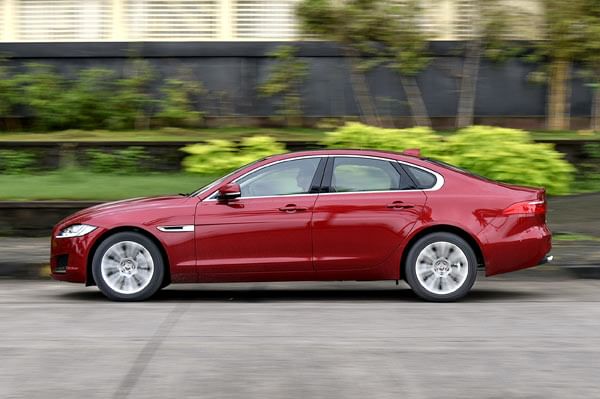
For those looking for performance, the other engine of choice will be of greater interest. It’s the familiar four-cylinder, 2.0-litre turbo-petrol unit that already does duty in many of JLR’s other models offered on the XF in the higher of its two states of tune. Read 240hp and 340Nm. That’s a near 60hp jump over the petrol versions of the A6, 5-series and E-Class, and straight off the bat, the XF feels a lot faster. The 0-100kph comes up in 7.62 seconds compared to the 520i’s 8.63 and it’s significantly quicker in roll-on acceleration too.
Flat-out performance is strong, and what makes the engine exciting is that there’s plenty of power in the upper reaches of the rev band. Flooring the throttle has the eight-speed automatic gearbox jump down as many ratios as needed to get to the meat of the powerband. However, when you do so, you can tell the gearbox isn’t the fastest eight-speeder around and there is a pause between command and execution. The paddle-shifters do help work around this issue and what is also great is that the electronics let you hold gear at the 6500rpm limiter in the gearbox’s S mode. Driven hard, the XF’s petrol engine sounds quite nice as four-cylinder units go with a racy snarl, giving a fitting soundtrack for the last 2000rpm of the rev range. Unfortunately, the petrol engine is not particularly quiet when you want it to be. It’s audible at idle and grumbles at middle revs. Once again, the gearbox tends to fumble at times when you need a quick dose of power.
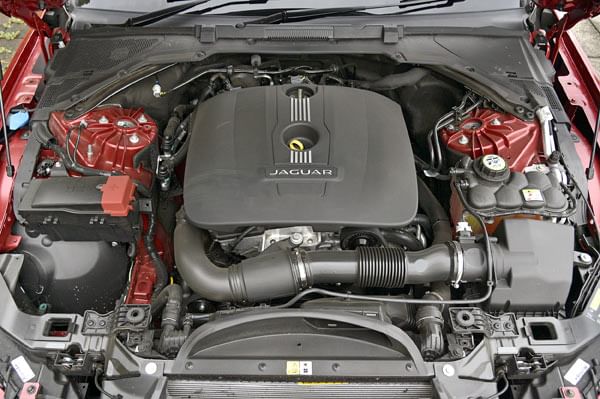
Where both versions of the XF shine is on the twisties. True to its name, the Dynamic mode adds the requisite dynamism to the rear-wheel drive XF, with the beautifully fluid electric power steering just weighing up by the right amount. In the corners, the XF feels like a big car but gives an immense sense of control with a sharp turn-in and neat handling. Body movements are well contained too. So, is this the sportiest of the large luxury sedans? It might just be.
In more everyday driving conditions, the XF has its strengths and weaknesses. The ride quality is largely impressive, with the Jag feeling nice and tied down at cruising speeds and absorbent enough in town. There is that European car firmness to the low-speed ride, but that’s a trait common to all cars of this segment. We didn’t have an issue with ground clearance either, but did find the suspension to thud on oversized speedbreakers, pointing to a harsh rebound. There is also more road noise than you’d expect. The XF does feel like a large car in town, but the steering effort is well judged.
Should I buy one?
It depends on your priorities. If you drive yourself, like the buzz of being in control of a strong petrol engine, and value handling finesse more than plastic finish, the XF 25T petrol is the luxury sedan for you. It is the most rewarding petrol car to drive in the segment this side of the mad V8 versions. And while the diesel XF isn’t a standout performer, it more than gets the job done too.
On the other hand, the XF won’t be quite as easy a sell for buyers to whom luxury comes above all else. True, the XF improves over the older model in key areas, but there’s still some way to go in terms of refinement and cabin quality. And that’s talking in terms of today’s competition. Remember, the XF will be up against the likes of the new S90 and the next-gen E-Class and 5-series soon enough. Simply put, the XF isn’t the revolution it ought to have been.
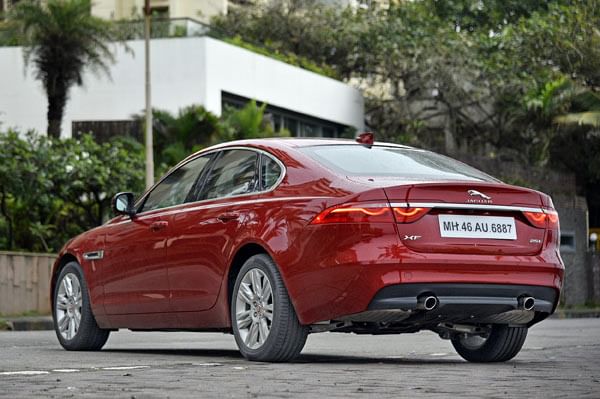
What makes matters that bit harder for the XF is pricing. Yes, the petrol version is more powerful than rivals, but you also have to pay a premium for the performance. The Prestige trim’s Rs 55.65 lakh (ex-showroom, Delhi) tag makes it costlier than rivals and the gap increases dramatically when you take into account the top-spec Portfolio version that costs Rs 61.85 lakh. The diesel range starts at a more realistic Rs 49.50 lakh for the ‘base’ Pure trim, but you’ll have to shell out Rs 62.1 lakh for the fully-loaded Portfolio. As a result, even in a segment where car buying budgets are flexible, the XF comes across as pricey. And that is a shame for what is otherwise a thoroughly likeable car.
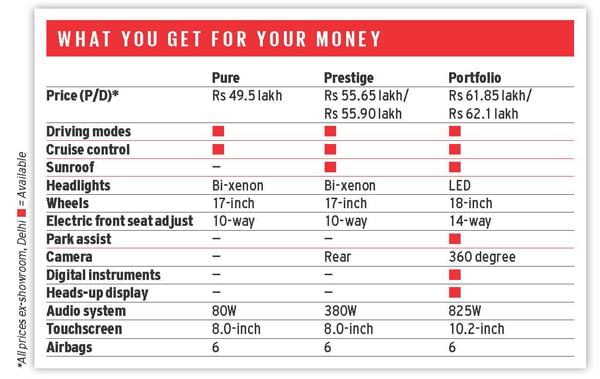

Jaguar XF price for the base model starts at ₹ 58.88 lakh and the top model price goes upto ₹ 72.59 lakh (on-road Delhi).Jaguar XF comes in 5 variants.The Jaguar XF Petrol engine on road price in Delhi ranges between ₹ 64.45 lakh - ₹ 70.30 lakh.The Jaguar XF Diesel engine on road price in Delhi ranges between ₹ 58.88 lakh - ₹ 72.59 lakh.
 Jaguar XF ₹ 58.88 - 72.59 lakh Jaguar XF ₹ 58.88 - 72.59 lakh |  BMW 5 Series ₹ 72.00 lakh - 1.79 crore BMW 5 Series ₹ 72.00 lakh - 1.79 crore |  Mercedes-Benz E-Class ₹ 72.92 lakh - 1.76 crore Mercedes-Benz E-Class ₹ 72.92 lakh - 1.76 crore |  Volvo S90 ₹ 69.65 lakh Volvo S90 ₹ 69.65 lakh |  Audi A6 NA Audi A6 NA |
Engine 1997-1999 cc | Engine 1995-4395 cc | Engine 1950-3982 cc | Engine 1969 cc | Engine 1798-1968 cc |
Mileage NA | Mileage 15.56-9.52 kpl | Mileage NA | Mileage NA | Mileage 15.26-18.53 kpl |
Fuel Type Diesel,Petrol | Fuel Type Petrol,Diesel | Fuel Type Petrol,Diesel | Fuel Type Diesel | Fuel Type Diesel,Petrol |
Airbags Yes | Airbags Yes | Airbags Yes | Airbags Yes | Airbags Yes |
Transmission Torque Converter Auto | Transmission Torque Converter Auto | Transmission Multi-Clutch Auto,Torque Converter Auto | Transmission Torque Converter Auto | Transmission Dual-Clutch Automatic |
The Jaguar XF offers a variety of color options. Jaguar XF is available in a range of 8 colors. The colors offered in Jaguar XF are Carpathian Grey, Rossello Red, Loire Blue, Firenze Red, Caesium Blue, Indus Silver, Santorini Black and Fuji White.
View all colours